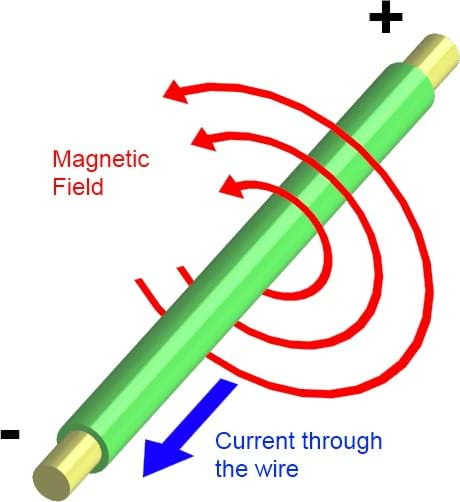Quick Look
Grade Level: 9 (8-10)
Time Required: 15 minutes
Lesson Dependency:
Subject Areas: Science and Technology
NGSS Performance Expectations:

| HS-PS2-5 |

Summary
The grand challenge for this legacy cycle unit is for students to design a way to help a recycler separate aluminum from steel scrap metal. In previous lessons, they looked at how magnetism might be utilized. In this lesson, students think about how they might use magnets and how they might confront the problem of turning off the magnetic field. Through the accompanying activity, students explore the nature of an electrically induced magnetic field and its applicability to the needed magnet for this design challenge.Engineering Connection
This lesson covers induced magnetic fields and builds into the design of electromagnets, which are science topics that many types of engineers must understand to do their work, such as designing electric motors and unlocking car doors. Students are asked to think about how they might use this information as if they are engineers challenged to design a device to separate steel from aluminum for a recycler.
Learning Objectives
After this lesson, students should be able to:
- Identify an electric current as a source of a magnetic field.
- Describe the magnetic field lines around a wire carrying an electric current.
Educational Standards
Each TeachEngineering lesson or activity is correlated to one or more K-12 science,
technology, engineering or math (STEM) educational standards.
All 100,000+ K-12 STEM standards covered in TeachEngineering are collected, maintained and packaged by the Achievement Standards Network (ASN),
a project of D2L (www.achievementstandards.org).
In the ASN, standards are hierarchically structured: first by source; e.g., by state; within source by type; e.g., science or mathematics;
within type by subtype, then by grade, etc.
Each TeachEngineering lesson or activity is correlated to one or more K-12 science, technology, engineering or math (STEM) educational standards.
All 100,000+ K-12 STEM standards covered in TeachEngineering are collected, maintained and packaged by the Achievement Standards Network (ASN), a project of D2L (www.achievementstandards.org).
In the ASN, standards are hierarchically structured: first by source; e.g., by state; within source by type; e.g., science or mathematics; within type by subtype, then by grade, etc.
NGSS: Next Generation Science Standards - Science
| NGSS Performance Expectation | ||
|---|---|---|
|
HS-PS2-5. Plan and conduct an investigation to provide evidence that an electric current can produce a magnetic field and that a changing magnetic field can produce an electric current. (Grades 9 - 12) Do you agree with this alignment? |
||
| Click to view other curriculum aligned to this Performance Expectation | ||
| This lesson focuses on the following Three Dimensional Learning aspects of NGSS: | ||
| Science & Engineering Practices | Disciplinary Core Ideas | Crosscutting Concepts |
| Plan and conduct an investigation individually and collaboratively to produce data to serve as the basis for evidence, and in the design: decide on types, how much, and accuracy of data needed to produce reliable measurements and consider limitations on the precision of the data (e.g., number of trials, cost, risk, time), and refine the design accordingly. Alignment agreement: | Forces at a distance are explained by fields (gravitational, electric, and magnetic) permeating space that can transfer energy through space. Magnets or electric currents cause magnetic fields; electric charges or changing magnetic fields cause electric fields. Alignment agreement: …and "electrical energy" may mean energy stored in a battery or energy transmitted by electric currents.Alignment agreement: | Empirical evidence is required to differentiate between cause and correlation and make claims about specific causes and effects. Alignment agreement: |
International Technology and Engineering Educators Association - Technology
-
Technological problems must be researched before they can be solved.
(Grades
9 -
12)
More Details
Do you agree with this alignment?
State Standards
Tennessee - Science
-
Understand magnetic poles, magnetic fields, and investigate electromagnetic induction.
(Grades
9 -
12)
More Details
Do you agree with this alignment?
-
Probe the fundamental principles and applications of electricity.
(Grades
9 -
12)
More Details
Do you agree with this alignment?
Worksheets and Attachments
Visit [www.teachengineering.org/lessons/view/van_cleanupmess_less3] to print or download.Pre-Req Knowledge
An understanding of the shape and nature of magnetic fields of permanent magnets and how to find magnetic field lines. An understanding of the flow of electricity in circuits.
Introduction/Motivation
(Have a magnet and a pile of aluminum and steel—materials from Magnet or Not? work well—available for a brief class demonstration.) Based on what we've looked at, a magnet will successfully separate steel from aluminum because the iron in the steel is affected by the magnetic field but the aluminum is not. (Use the magnet to pick up some of the steel from the aluminum.) So you have picked up the steel and separated it from the aluminum. You still have a problem. What must you still do to finish your job? (Briefly discuss student ideas, guiding them toward the need to remove the steel from the magnet.)
To summarize, you use the magnet to pick up the steel, then you move the magnet and steel to your new steel pile. Now, you must remove the steel from the magnet. And we're not just talking a single piece of (say whatever steel material you are holding attached to the magnet). We're talking possibly large amounts of scrap metal. How are you going to get the steel off of the magnet? (Listen to and discuss student ideas. Make sure they understand that this is not just a matter of pulling the steel scrap off—in order to pick up large amounts of scrap the magnet must be strong, which prevents simply pulling the steel off. Additionally, that requires manual labor, a solution already deemed not cost-effective. Direct them toward the need to turn off the magnet.)
If we're going to turn off the magnet, we need a magnet made from something we can turn off. What options do we have of things we can turn off? (Listen to and briefly discuss student ideas. Quickly direct them to the option of electricity.) If we can find a magnetic field around an electric current, we can turn it off by turning off the electric current. (Begin the Circuits and Magnetic Fields associated activity.)
Lesson Background and Concepts for Teachers
Legacy Cycle Information
This lesson continues the Review and Revise step. Students have identified a magnetic field as a solution to separating steel from aluminum but still have additional work to do in properly designing and controlling that magnetic field. This lesson and accompanying activity provides them the knowledge of induced magnetic fields necessary to completely designing an electromagnet.
Lecture information
In the activity, students are investigating a concept called magnetic induction, although that term is not used until the summary of the lesson. Electric fields and magnetic fields are closely linked. Magnetic fields affect moving electrons, a principle that underlies iron's, nickel's, and cobalt's easy attraction to magnets. The reverse is also true: moving electrons create magnetic fields.The net movement of electrons in a simple circuit is sufficient to generate a magnetic field. The stronger the electric current, the stronger the magnetic field induced is. If there is no electric current, then there is no magnetic field.
The magnetic field is perpendicular to the direction of the current or the wire carrying it. This requires three-dimensional thinking in order to conceptualize it and also makes for a slightly elaborate lab setup. The magnetic field wraps around the wire in concentric circles, with the field growing weaker the further from the wire it is observed. The direction of the wrapping, or curl, follows what is called the "right hand rule"—if the thumb of one's right hand points along the wire in the direction of current flow, taken to be from the positive to negative terminals of the battery, then the magnetic field wraps around the wire in the direction of the fingers of the right hand.
Engineers use these principles of electricity and magnetism in many different applications. A few examples are electric motors, solenoids that unlock car doors, and electromagnets for applications such as a separating trash as described in this unit. 
Associated Activities
- Circuits and Magnetic Fields - Students apply the same compass techniques as the previous activity to explore the magnetic field around a current carrying wire. Through the activity, they learn the right hand rule to determine the direction of current flow.
Lesson Closure
(Conduct this closure after students have completed the accompanying activity.) We have one problem left. The magnetic field created by the electric current, or the induced magnetic field, does not match the magnetic field of a permanent magnet. We need to design the shape of the wire so that its induced magnetic field closely matches the magnetic field of a permanent magnet. But first, you've got to check to see how well you know all these magnetic fields. We'll discuss this in the next activity. (Hand out the Magnetic Field Check.)
Assessment
Lesson Concepts Formative Assessment: Administer the six-question Magnetic Field Check, giving students no additional aids other than the advice "use the right hand rule." Review their answers to gauge their comprehension before moving on.
Subscribe
Get the inside scoop on all things TeachEngineering such as new site features, curriculum updates, video releases, and more by signing up for our newsletter!More Curriculum Like This

Students induce EMF in a coil of wire using magnetic fields. Students review the cross product with respect to magnetic force and introduce magnetic flux, Faraday's law of Induction, Lenz's law, eddy currents, motional EMF and Induced EMF.

Students complete the grand challenge of this unit and design an electromagnet to separate steel from aluminum for a recycler. In order to do this, they compare the induced magnetic field of an electric current with the magnetic field of a permanent magnet and then make the former look like the latt...

After a demonstration of the deflection of an electron beam, students review their knowledge of the cross-product and the right-hand rule with example problems. Students apply these concepts to understand the magnetic force on a current carrying wire. Through the associated activity, students furthe...
Copyright
© 2013 by Regents of the University of Colorado; original © 2011 Vanderbilt UniversityContributors
Justin Montenegro , Glencliff High School, Nashville TNSupporting Program
VU Bioengineering RET Program, School of Engineering, Vanderbilt UniversityAcknowledgements
The contents of this digital library curriculum were developed under National Science Foundation RET grant nos. 0338092 and 0742871. However, these contents do not necessarily represent the policies of the NSF, and you should not assume endorsement by the federal government.
Last modified: September 5, 2017








User Comments & Tips